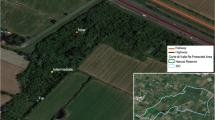Summary
In order to test the nature of the information acquired by pigeons at home and utilized as “map” component in their navigational mechanism, groups of birds were kept since fledging time in glass corridors, which had their main axis oriented E-W (or ESE-WNW). Referring to the quadrants centered by these directions as “experimental” quadrants, the treatment of the birds was as follows. Whenever a wind was blowing from one of the “experimental” quadrants, C1-and C-birds were subjected to an artificial air current blowing from the center of the same quadrant, and E-birds to air currents from the center of the opposite quadrant. C2-birds, reared in a corridor which was unscreened at both ends, were not treated with artificial winds and could perceive the natural winds from the “experimental” quadrants. Finally, S-birds were never exposed to either natural or artificial winds.
When released from directions comprised in the “xperimental” quadrants, C-, C1-, and C2-birds were homeward oriented, while E-birds oriented themselves toward the opposite direction (Fig. 7), and S-birds' bearings were random. The homing performances of E-birds were poorer than those of the other birds, and on some releases, disastrous.
It is concluded that the information that pigeons acquire at home and then use for navigational purposes is wind borne and can be conveyed by an artificial air current. This confirms previous results which indicated the olfactory nature of the information.
Similar content being viewed by others
References
Baldaccini, N.E., Benvenuti, S., Fiaschi, V., Ioalé, P., Papi, F.: Pigeon homing: effects of manipulation of sensory experience at home site. J. comp. Physiol.94, 85–96 (1974)
Baldaccini, N.E., Benvenuti, S., Fiaschi, V., Papi, F.: Pigeon navigation: effects of wind deflection at home cage on homing behaviour. J. comp. Physiol.99, 117–186 (1975)
Baldaccini, N.E., Benvenuti, S., Fiaschi, V., Loalé, P., Papi, F.: Investigation of pigeon homing by means of deflector cages. Proceedings in Life Sciences. Berlin, Heidelberg, New York: Springer 1978
Batschelet, E.: Statistical methods for the analysis of problems in animal orientation and certain biological rhythms. Washington: American Institute of Biological Sciences 1965
Batschelet, E.: Recent statistical methods for orientation data. In: Animal orientation and navigation. Galler, S.R., Schmidt-Koenig, K., Jacobs, G.J., Belleville, R.E. (eds.), NASA SP-262, pp. 61–91. Washington: U.S. Goverment Printing Office 1972
Benvenuti, S., Fiaschi, V., Foà, A.: Homing behaviour of pigeons disturbed by application of an olfactory stimulus. J. comp. Physiol.120, 173–179 (1977)
Hartwick, R.F., Foà, A., Papi, F.: The effect of olfactory deprivation by nasal tubes upon homing behaviour in pigeons. Behav. Ecol. Sociobiol.2, 81–89 (1977)
Kiepenheuer, I.: Inversion of the magnetic field during transport: its influence on the homing behaviour of pigeons. Proceedings in Eife Sciences. Berlin, Heidelberg, New York: Springer 1978
Papi, F.: The olfactory navigation system of the homing pigeon. Verh. Dtsch. Zool. Ges.69, 184–205 (1976)
Papi, F., Fiore, L., Fiaschi, V., Benvenuti, S.: Olfaction and homing in pigeons. Monitore zool. ital. (N.S.)6, 85–95 (1972)
Papi, F., Fiore, L., Fiaschi, V., Benvenuti, S.: An experiment for testing the hypothesis of olfactory navigation of homing pigeons. J. comp. Physiol.83, 93–102 (1973)
Papi, F., Ioalé, P., Fiaschi, V., Benvenuti, S., Baldaccini, N.E.: Olfactory navigation of pigeons: the effect of treatment with odorous air currents. J. comp. Physiol.94, 187–193 (1974)
Papi, F., Ioalé, P., Fiaschi, V., Benvenuti, S., Baldaccini, N.E.: Pigeon homing: cues detected during the outward journey influence initial orientation. Proceedings in Life Sciences. Berlin-Heidelberg-New York: Springer 1978
Siegel, S.: Nonparametric statistics: for the behavioral sciences. New York: McGraw Hill Book Co. 1956
Wallraff, H.G.: Über die Heimfindeleistungen von Brieftauben nach Haltung in verschiedenartig abgeschirmten Volieren. Z. vergl. Physiol.52, 215–259 (1966)
Wallraff, H.G.: Weitere Volierenversuche mit Brieftauben: wahrscheinlicher Einfluß dynamischer Faktoren der Atmosphäre auf die Orientierung. Z. vergl. Physiol.68, 182–201 (1970)
Wiltschko, R., Wiltschko, W., Keeton, W.T.: The effect of outward journey in an altered magnetic field in young homing pigeons. Proceedings in Life Sciences. Berlin, Heidelberg, New York: 1978
Author information
Authors and Affiliations
Additional information
Dedicated to Prof. Dr. H. Autrum, on occasion of his seventieth birthday
This study was supported by the Cosiglio Nazionale delle Ricerche. We thank the Command of the Brigata Paracadutisti “Folgore”, Italian Army, which kindly allowed us to use a power boat for the releases from over the sea. We also wish to thank Dr. R.F. Hartwick for valuable help with some experiments and for stimulating discussions, Mr G. Mela and Mr D. Moretti for constructing the control drices for the fans.
Rights and permissions
About this article
Cite this article
Ioalé, P., Papi, F., Fiaschi, V. et al. Pigeon navigation: Effects upon homing behaviour by reversing wind direction at the loft. J. Comp. Physiol. 128, 285–295 (1978). https://doi.org/10.1007/BF00657603
Accepted:
Issue Date:
DOI: https://doi.org/10.1007/BF00657603




